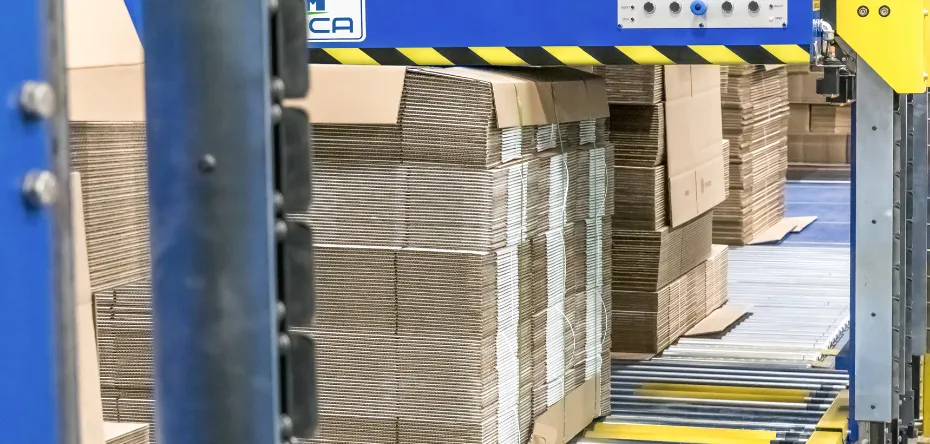7 Tips for Choosing the Best Corrugated Compression Unitizer
After manufacturing the best boxes, die cuts, displays or corrugated sheets in the industry, there’s another step in the process: compress and strap the load and get it on a truck. Hopefully, the compression unitizers are up to the challenge, because if the product doesn’t show up looking great, there could be cause for quality concerns.
So how does a box plant or sheet feeder facility decide what they need when it comes to unitizing their loads? Here are seven tips from EAM-Mosca Corporation’s Project Manager, Phil Pistun, for making the correct decisions with this essential purchase.
1. Determine how much capacity is needed.
The only thing worse than buying too much horsepower is buying too little, and then having to correct the mistake later. Getting the right solution for your current needs, while keeping in mind what the future may hold, is key. Have a qualified strapping machine specialist perform an audit of your production capacity and load types.
Once completed, a quick review should reveal how many unitizers and how many strapping heads are needed.
2. Establish speed requirements.
Strapping machines need to be fast enough that your operator doesn’t have to wait for the next load to be released. While most modern-day unitizers can process loads faster than an operator can dress them, you also need to think about those instances when production is running at full capacity and the mainline gets backed up. Extra speed can certainly come in handy.
Another significant consideration is making sure that you place straps in the best locations using as few platen cycles as possible.
3. Determine automation needs.
Many smaller plants with a single unitizer can manually position loads and automation is an unneeded expenditure. But when you have multiple unitizers, a system that measures the loads and automatically positions them for strapping will pay big dividends. Most unitizer manufacturers generally sell their machines as “OEM”, meaning the conveyor company will supply this automation and tell the strapper what to do.
This handshake arrangement has been proven to work quite well, with the conveyor company also controlling all upstream and downstream logistics.
4. How much and what kind of compression is needed?
Compression can be generated by an electric drive, a hydraulic pump, or pneumatics. Each has benefits and drawbacks, so be sure to discuss these with your supplier.
5. What strapping material is best?
Today, many customers are using 3/8″ polyester strapping. This material obviously has a cost-benefit over the 7/16″ or 1/2″ polyester or polypropylene traditionally used in this application. In addition, 3/8″ strapping has more footage per coil, meaning fewer coil changes.
You should discuss which strapping material is best suited for your needs before ordering and installing your equipment.
6. A load-centering device is recommended.
In almost every case, you need a load-centering device to break the bottom dunnage. This is especially important on longer units where the bottom dunnage is multiple overlapping pieces. The centering device provides a consistent break that leads to a more uniform strapped unit than if the strap alone tries to create the break. Also, a centered load will always be underneath the seal made by the strapping head. Finally, it is important that unitizers with an internal turntable have the load centered for stable lifting and accurate positioning after rotation.
7. What about dunnage?
The type, amount and application of dunnage is very important in ensuring that loads looks great and is delivered the way it left. Too much dunnage can often result in the strapping being unable to pull tight up against the load, which will result in loose straps once the dunnage “breaks”. Too little dunnage may contribute to the strap cutting into product, causing customers to complain about damage. Using the right dunnage the right way is a critical part of making sure customers are happy.
Some simple investigation and discussion with your strapping equipment manufacturer will bring about a well-conceived, smoothly running unitizing process. Take advantage of the expertise available from strapping providers and material handling integrators in designing your new or upgraded unitizing system.
Contact EAM-Mosca for more Info
EAM-Mosca Corporation provides high-performance strapping system solutions to a variety of industries, including food, graphic arts, mailing, fulfillment, logistics, corrugated, wood, and other industrial or consumer goods. We combine innovative equipment with strapping materials manufactured to maximize machine performance and customer support programs that help our customers to meet their performance and productivity goals.
To learn more about any of EAM-Mosca’s other productivity enhancing strapping systems, please call us at 800-456-3420, or email us. You can also connect with EAM-Mosca on YouTube, Twitter, Facebook, and LinkedIn via the links above.


